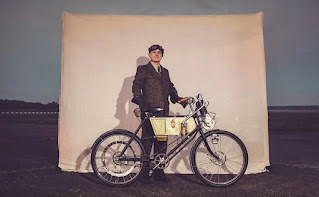 |
| While looking muscular the Royal Enfield Concept SG650 is still a streamliner. |
This week Royal Enfield showed the world, at the premier event for the motorcycle industry, that it cares deeply about its history and yet has its eyes on the future.
At the EICMA 2021 motorcycle show in Milan Royal Enfield unveiled its SG650 Concept. It is a streamlined looker with a clear connection to Royal Enfield's past but with a robust, muscled tone that could play well in an international market that considers brawnier better.
The "SG" could indicate the model name "Shot Gun," a name Royal Enfield has reserved for a production motorcycle.
“The goal: to build a unique concept motorcycle that pays homage to Royal Enfield’s rich history of custom motorcycles, but one that wasn’t encumbered by the past," said Royal Enfield Chief of Design Mark Wells.
After all, can Royal Enfield do retro design forever?
Yes. If it's real and at the same time relevant to present times. What do you call that?
Wells called it "neo-retro."
 |
| Concept SG650 reimagines the Royal Enfield nacelle. |
Adrian Sellers, Group Manager, Industrial Design and lead for the SG650 Concept project, explained the details:
"The tank has been CNC billet machined from a solid block of aluminum, as have the wheel rims with integrated ABS, bespoke designed brake calipers and dual front brake discs. The upside-down forks, integrated aluminum top yoke/nacelle unit and low rise extra-wide bars with all aluminum switch cubes all add elements of originality and design progression to the concept; while the twin rear shocks, mounted to the classic chassis loop, hand-stitched black leather floating solo seat are a clear nod to our past."
Also seeing the light of day (and absorbing all the light in the room) were the Royal Enfield 120th Year Anniversary INT 650 and Continental GT 650.
 |
| Royal Enfield 120th Year Anniversary Continental GT 650. |
Completely blacked out and featuring "black chrome" tanks, they look take-no-prisoners fast and edgy. The emphasis on black and custom parts visually changes the Interceptor and Continental GT from frisky "let's go to the beach" friendly to "let's go downtown and mix it up."
"The motorcycles will also come equipped with a range of Genuine Motorcycle Accessories such as fly screens, engine guards, heel guards, touring and bar-end mirrors among others in a defining black to accent the overall design," is how the press release put it.
But wait. They're still Royal Enfields.
The new black chrome technology joins the time-honored hand-painted pinstripes on the tanks. Tank-top badges will carry the unique serial number of each motorcycle, indicating it is one of only 60 120th Year Anniversary Interceptors or Continental GTs released in each of four world regions.
That means only 120 total for North America. In North America, the Royal Enfield 120th Year Anniversary Edition Twins will be made available via a limited time online sale in early 2022, Royal Enfield North America announced.
 |
| Handcrafted bronze badge for limited edition Royal Enfields. |
The brass badges are crafted in collaboration with a family of multi-generational artisans in India.
That's Royal Enfield: making new traditions while keeping old ones.
(The unbeloved oil spot on your garage floor is gone, however, leaving only diehards like me the joy of arranging a cardboard nest under a 1999 Royal Enfield Bullet when parked.)
One day after revealing these wonders Wednesday at EICMA, Royal Enfield summoned the motoring press back to show off something uniquely out of Royal Enfield's history.
It's "Project Origin," not a restoration, but the fresh creation of an exacting replica of the first Royal Enfield motorcycle, of 1901.
What an odd and wonderful thing to re-create. The 1901 prototype was an astonishing design, intended to evade competitor patents. It fastened the motor to the steering head, actually above the front wheel.
 |
| No one would imagine a motorcycle like this today, but Royal Enfield cared enough to recreate it. |
Some moped motors have been attached that high, to power the front wheel. But the 1901 Royal Enfield prototype didn't drive the front wheel. It drove the rear wheel, with an immensely long drive belt. No one else had done this (or likely ever would).
Looking at it your first impression would be "that thing is going to fall over if it doesn't first take off my left leg."
No working model or blueprints of the original are known although there are photos and contemporary descriptions. Historian, writer and rider Gordon May suggested that Royal Enfield try to build one.
Royal Enfield credits teams in England and India and vintage motorcycle experts with carrying off the task.
It's the kind of thing companies do only when they truly care about their history. Of all the surprises Royal Enfield unveiled at EICMA, I think Project Origin the most amazing.
Here is the video of Royal Enfield's Wednesday unveilings at EICMA:































Thanks, David is so nice to know the things you do are appreciated by people with the same love for the brand.
ReplyDeleteCheers
Mark
That's really impressive to build a working replica of the first RE. Looking back 100+ years, we can see the obvious design flaws. But back then those folks built from imagination,by hand,with trial and error. They had to start somewhere, with something.There were no computers, no CAD to help them sort things out virtually. How many today would have the intestinal fortitude or dare I say,BRAINS, to do ANYTHING without their smartphones and laptops ????
ReplyDelete